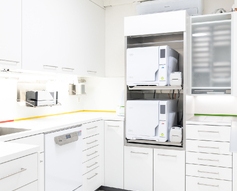Larger defects
Today, despite inlay technology, crowns are still sometimes made. Special requirements must, however, be met:
- The tooth being treated has been crowned before and needs to be retreated.
- The tooth is so severely damaged that an inlay or filling is no longer an option.
- The tooth has had root canal treatment: sometimes this can only be dealt with using a crown for reasons of stability.
- A tooth is missing: after an implant is put in place, it is then crowned.
What types of crowns are used?
- All ceramic crowns
These crowns contain no metal.
Advantages
- Suitable for everyone with allergies
- Very high aesthetic quality
- Particularly suited for the front teeth
Disadvantage
- Expensive process
- Not suitable for patients who grind (danger of breakage)
Cost
- Between 1,800 and 2,200 francs per tooth including technician costs
- Gold ceramic crowns
These crowns contain a scaffold with a high gold content (at least 75% gold, the remainder is other precious metals).
Advantages
- High aesthetic quality
- Suitable for front and side teeth
- Very stable
- Also suitable for people with allergies
Disadvantages
- Not aesthetically suitable for very white teeth.
Cost
- Between 1,600 and 1,900 francs per tooth including technician costs





